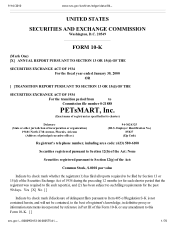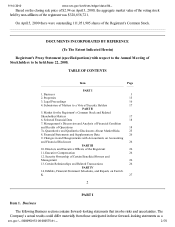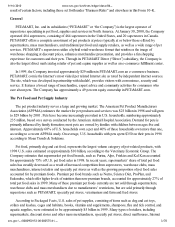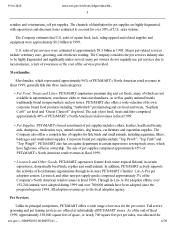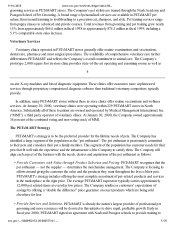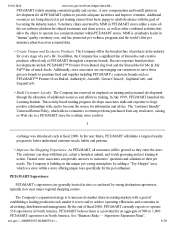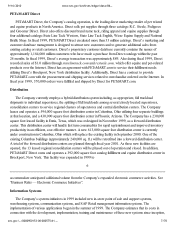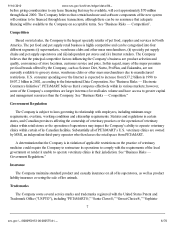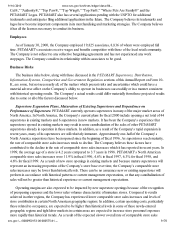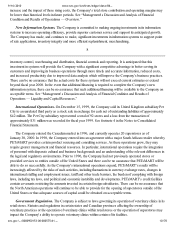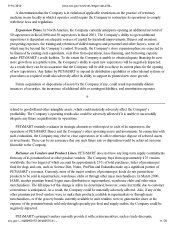Petsmart 2000 Annual Report Download - page 9
Download and view the complete annual report
Please find page 9 of the 2000 Petsmart annual report below. You can navigate through the pages in the report by either clicking on the pages listed below, or by using the keyword search tool below to find specific information within the annual report.
Cat®,” “Authority®,” “Top Paw®,” “Top Wing®,” “Top Fin®,” “Where Pets Are Family®” and the
PETsMART Logos. PETsMART also has several applications pending with the USPTO for additional
trademarks and anticipates filing additional applications in the future. The C ompany believes its trademarks and
logos have become important components in its merchandising and marketing strategies. The Company believes
it has all the licenses necessary to conduct its business.
Employe es
As of January 30, 2000, the Company employed 19,825 associates, 8,836 of whom were employed full
time. PETsMART’ s associates receive wages and benefits competitive with those of the local retail community.
The Company is not subject to any collective bargaining agreements and has not experienced any work
stoppages. The Company considers its relationship with its associates to be good.
Business Risks
The business risks below, along with those discussed in the PETsMART Superstores, Distribution,
Information Systems, Competition and Government Regulation sections of this Annual Report on Form 10-
K, are some, but not necessarily all, of the matters which present risks and uncertainties which could have a
material adverse affect on the C ompany’ s ability to operate its businesses successfully or in a manner consistent
with historical operating results. The Company’ s actual results could differ materially from those projected results
due to some or all of the factors discussed below.
Superstore Expansion Plans, Maturation of Existing Superstores and Dependence on
Performance of Superstore. PETsMART currently operates superstores in many of the major market areas of
North America. In North America, the Company’ s current plans for fiscal 2000 include opening a net total of 44
superstores in existing markets and 6 superstores in new markets. It has been the Company’ s experience that
superstores opened in existing markets may result in some cannibalization of the sales of other PETsMART
superstores already in operation in those markets. In addition, as a result of the Company’ s rapid expansion in
recent years, many of its superstores are still relatively immature. Approximately one- half of the C ompany’ s
North America superstores have been opened since the beginning of fiscal 1996. As superstores reach maturity,
the rate of comparable store sales increases tends to decline. The Company believes these factors have
contributed to the decline in the rate of comparable store sales increases which it has reported in recent years. In
1999, the average age of a store is 4.2 years compared to 3.7 years in 1998. PETsMART’ s North American
comparable store sales increases were 11.9% in fiscal 1996, 4.6% in fiscal 1997, 6.3% for fiscal 1998, and
4.6% for fiscal 1999. As a result of new store openings in existing markets and because mature superstores will
represent an increasing proportion of the Company’ s store base over time, the Company’ s comparable store
sales increases may be lower than historical levels. There can be no assurance new or existing superstores will
perform in accordance with historical patterns or current management expectations, or that any cannibalization of
sales will not be greater than historical experience or current management expectations.
Operating margins are also expected to be impacted by new superstore openings because of the recognition
of preopening expenses and the lower sales volumes characteristic of immature stores. Compared to results
achieved in other regions, the Company has experienced lower comparable store sales increases and levels of
store contribution in certain North American geographic regions. In addition, certain operating costs, particularly
those related to occupancy, are expected to be higher than historical levels in some of these newly-entered
geographic regions and tight labor markets in certain areas are expected to increase store personnel expenses
more rapidly than historical trends. As a result of the expected slower overall rate of comparable store sales
9/16/2010 www.sec.gov/Archives/edgar/data/86…
sec.gov/…/0000950153-00-000575-d1.… 9/70

